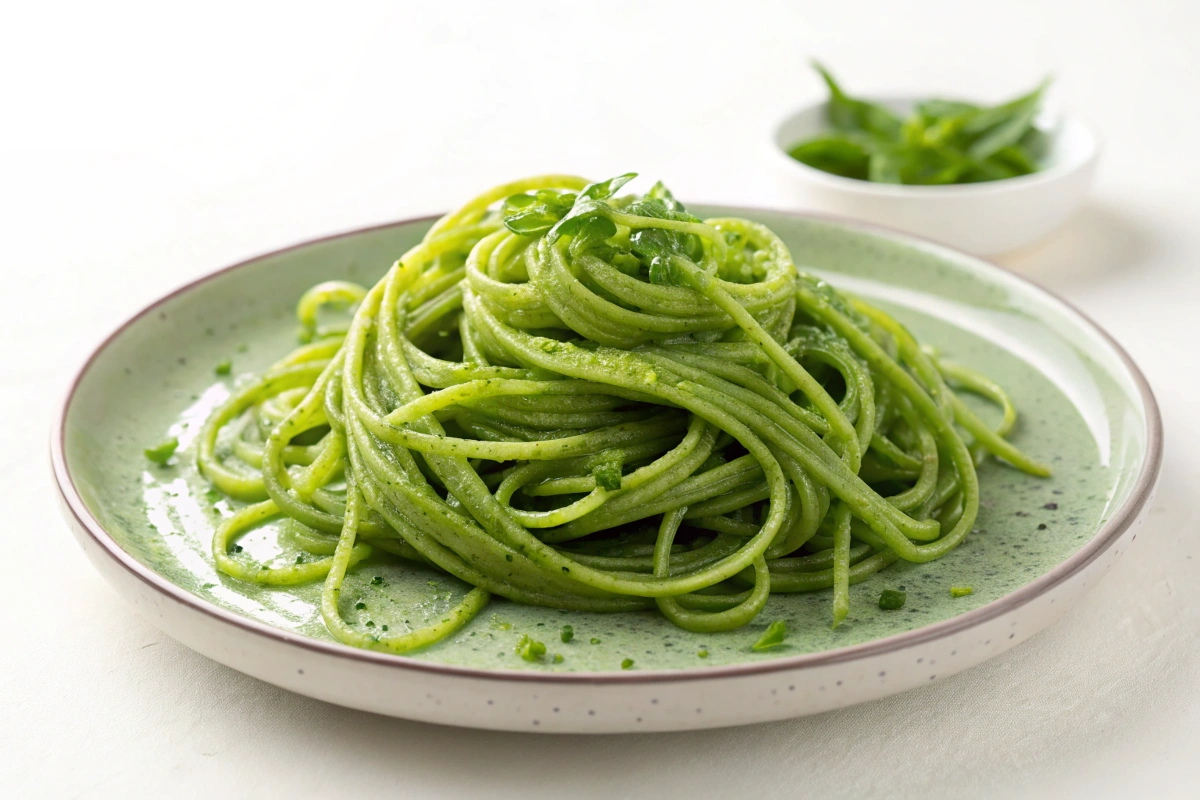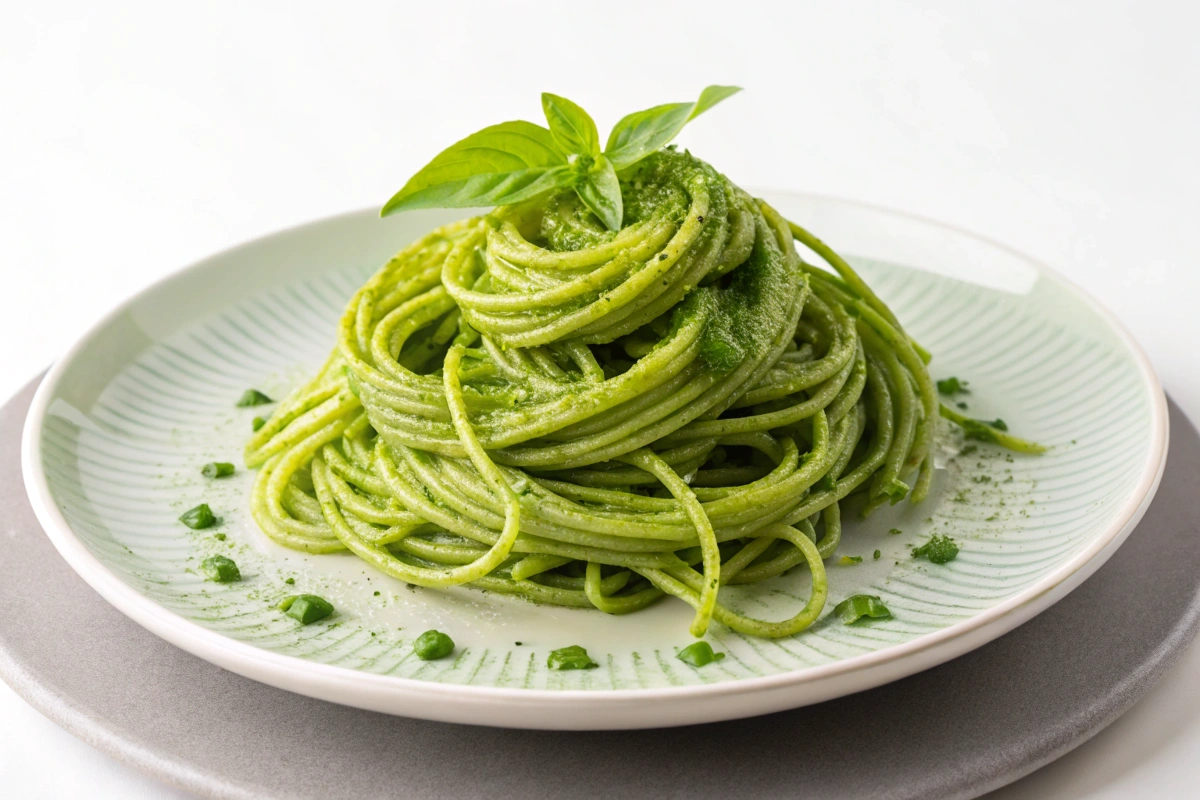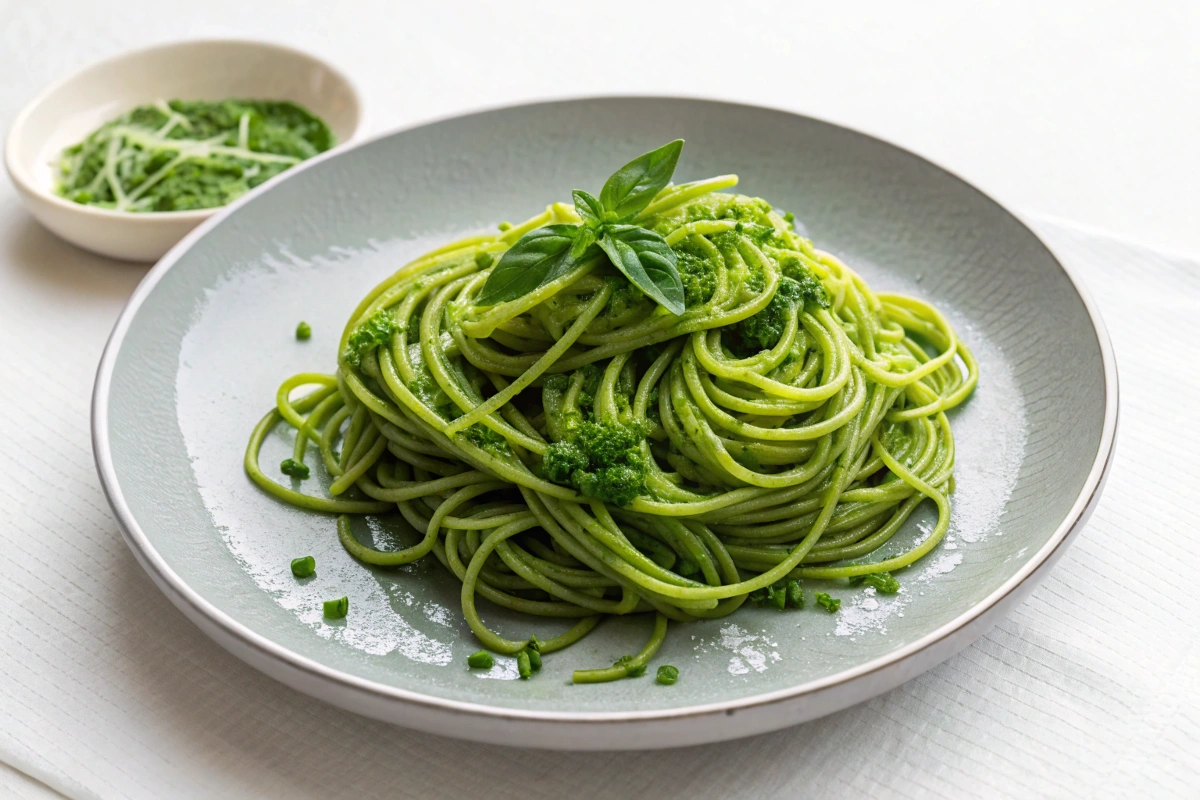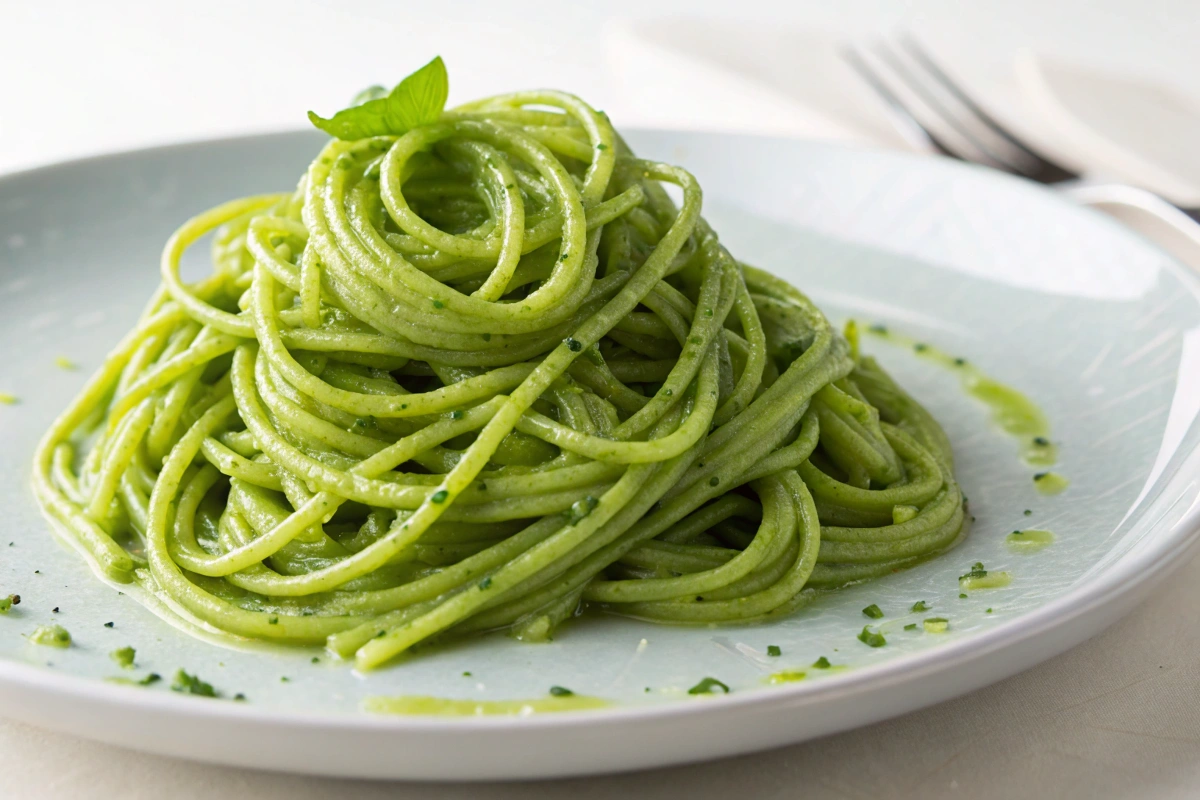This article explores the calorie count in a cup of green spaghetti and factors affecting it. We’ll look at different types of green spaghetti and how to enjoy them while maintaining a balanced diet.
Understanding Green Spaghetti and Calories
Green spaghetti, often enriched with vegetables such as spinach or kale, presents a vibrant and nutritious twist on traditional pasta. However, the calorie count can vary. Therefore, it’s essential to understand the components that contribute to its overall calorie content. Essentially, the calories in a cup of green spaghetti depend largely on the ingredients used in its preparation. Furthermore, different cooking methods and portion sizes also play a role in the final calorie count.
The Basics of Calories in Green Spaghetti
-
Pasta Base: The type of pasta used, whether regular wheat or a gluten-free option, affects the calorie count. Accordingly, whole wheat options might provide more fiber, but the calorie difference isn’t dramatic.
-
Vegetable Additions: The specific vegetables and the amounts used can influence the final calorie number. Generally, leafy greens are low in calories, but adding vegetables that contain more starch could raise the calorie count slightly.
-
Sauces and Add-ins: The choice of sauces, oils, and cheese contributes significantly to the calorie count. Indeed, creamy sauces will add more calories compared to tomato-based sauces.
How Many Calories Are in a Cup of Green Spaghetti? A Detailed Look
Accordingly, the exact calorie count for a cup of green spaghetti isn’t a fixed number, but it is generally between 200 and 400 calories. However, this can change based on the recipe. Also, portion sizes can have a great impact on the overall calorie consumption. Therefore, it’s vital to be mindful of your serving sizes when enjoying green spaghetti. Furthermore, homemade versions allow for more control over calorie counts.
Calories in Different Green Spaghetti Variations
-
Spinach Spaghetti: Consequently, using spinach to color and enrich the pasta may add some nutrients but will not drastically change the calorie amount. For instance, a cup may contain 220 to 270 calories, depending on the sauce. However, the exact number can differ based on the quantity of spinach.
-
Kale Spaghetti: Similarly, incorporating kale will change the flavor, texture, and nutritional content. A cup could have about 210 to 260 calories. Therefore, consider that kale is slightly less calorie-dense than spinach, though the difference is minimal.
-
Pesto Green Spaghetti: Comparatively, using pesto will dramatically increase the calorie count due to the higher fat content. A cup can contain between 300 to 400 calories or more. Specifically, pesto is made with oil, cheese, and nuts, which are high in calories.
-
Oil-based Green Spaghetti: Therefore, oil-based sauces will increase calorie count. A cup can range from 250 to 350 calories. Indeed, the type and amount of oil used significantly impact this calorie range. Moreover, adding garlic and other herbs will contribute flavor without adding significantly to the calorie count.
-
Cream Sauce Green Spaghetti: Subsequently, adding a cream-based sauce dramatically increases the calorie count, often making this the highest calorie option. A cup could easily exceed 400 calories, depending on the richness of the cream sauce.
-
Lemon and Herb Green Spaghetti: Finally, a light lemon and herb-based sauce offers a lower calorie option, often ranging from 200 to 250 calories per cup. Chiefly, this option focuses on flavor without the added fats.
How Many Calories Are in a Cup of Green Spaghetti Based on Portion Sizes
-
Standard One-Cup Serving: Generally, recipes are designed around one-cup servings. Thus, this quantity offers a reasonable estimate. However, ensure that you are using a standard measuring cup for the most accurate estimation of the calorie count.
-
Restaurant Servings: Chiefly, restaurant portions may be larger, therefore, having higher calorie counts. Indeed, restaurant servings may range from one-and-a-half to two cups, making the calorie count significantly higher.
-
Home-cooked Portions: Conversely, home-cooked portions can be controlled, thus, allowing you to manage calorie consumption more efficiently. Therefore, using measuring tools at home can aid in accurately portioning your green spaghetti. Additionally, being mindful of your serving size is essential for calorie control.
Factors Influencing the Calorie Count
Additionally, several factors can influence the calorie count of a cup of green spaghetti. Furthermore, it is important to consider these factors when estimating or calculating the calorie content of your meals. Moreover, understanding these factors can help you make informed and healthier dietary choices. Essentially, being aware of these influences ensures you are in control of your overall calorie intake.
Pasta Type and Calories
-
Refined Wheat Pasta: Basically, this is the most common base. Undoubtedly, it has a moderate calorie count. Specifically, refined wheat pasta is higher in carbohydrates than whole wheat options.
-
Whole Wheat Pasta: Eventually, while rich in fiber, it has a similar calorie count to refined versions. Comparatively, whole wheat pasta is a healthier alternative, but not significantly lower in calories.
-
Gluten-Free Options: However, these might have variations in calorie depending on the starch used. Specifically, options like brown rice or corn based pasta can alter the count. Indeed, some gluten-free options can have a slightly higher calorie count.
Vegetables Used and their Impact on Calories
-
Spinach: Another option, a low calorie choice that adds vitamins and minerals. Moreover, spinach is an excellent source of iron and antioxidants.
-
Kale: Similarly, also low in calories but nutrient-dense. Furthermore, kale offers a great source of vitamins K and A.
-
Broccoli: Comparatively, adds more fiber and nutrients but slightly more calories than leafy greens. Also, broccoli adds a good amount of fiber, contributing to a more satisfying meal.
-
Other Vegetables: Furthermore, zucchini and asparagus can be added to increase the nutritional value while keeping the calories low. Indeed, these vegetables contribute vitamins, minerals, and fiber without significantly increasing the calorie count. Finally, variety is key for a balanced and nutritious meal.
Sauces and Calories
-
Tomato-Based Sauces: Usually, low in calories, but check for added sugars. Specifically, always read the labels of store-bought sauces, as many contain hidden sugars.
-
Cream-Based Sauces: Chiefly, high in calories and fats. Additionally, cream sauces often contain a large amount of saturated fats.
-
Pesto: Indeed, contains healthy fats but adds many calories due to oils and nuts. Accordingly, while pesto provides beneficial fats, portion control is vital.
-
Oil-Based Sauces: Generally, can increase calories, especially if used excessively. Subsequently, olive oil and other oils should be measured rather than added freely.
Added Ingredients and Their Calorie Contributions
-
Cheese: Moreover, shredded cheese significantly increases the calorie count. Specifically, some cheeses are higher in fat and calories than others, so be mindful of the type and quantity you are using.
-
Meat: Another addition that can elevate calories, especially fatty meats. However, opting for lean meats can help reduce the overall calorie count.
-
Oils: Particularly, added oils can increase calories. Accordingly, measure carefully. Therefore, using a spray bottle of oil can be a good way to reduce the amount of oil used.
-
Nuts: Basically, adding nuts will introduce fats and thus, higher calories. Nevertheless, nuts offer healthy fats, but the portion size should be watched closely.
How to Choose Healthier Green Spaghetti
Consequently, choosing healthier green spaghetti involves making wise choices with ingredients and portion control. Furthermore, being mindful of your choices can contribute to a balanced and healthier meal. Moreover, by selecting healthier alternatives, you can enjoy green spaghetti without compromising your diet. Essentially, making smart choices will have a positive impact on your overall well-being.
Choosing the Right Pasta
-
Whole Wheat: Indeed, this option provides more fiber, contributing to a more satisfying meal. Specifically, the higher fiber content of whole wheat pasta promotes a feeling of fullness.
-
Gluten-Free: Furthermore, options like brown rice or quinoa based choices can be more nutritious than regular pasta. However, the calorie count of these varieties should still be considered.
-
Lower Carbohydrate Options: Specifically, zucchini noodles or vegetable spirals can reduce overall carbohydrates and calories. Moreover, these alternatives are also a good way to increase your vegetable intake. Indeed, opting for spiralized vegetables as a base is a good choice for those on a low-carb diet.
Smart Vegetable Additions
-
Leafy Greens: Specifically, spinach and kale are excellent for adding volume and nutrients without many calories. Additionally, these vegetables are packed with vitamins and minerals that are vital for overall health.
-
Variety: Another way is to use a variety of colorful vegetables, not just green ones, to boost nutrition. Indeed, a range of colors provides a diverse array of nutrients and antioxidants.
-
Freshness: Finally, choose fresh vegetables over canned ones to reduce added sodium and preservatives. Chiefly, fresh vegetables offer superior flavor and nutritional benefits.
Choosing Lighter Sauces and Enhancements
-
Tomato-Based: Comparatively, low in calories and rich in flavor. Also, tomato-based sauces are a great way to add vitamins and minerals to your meal.
-
Herbs and Spices: Undoubtedly, use them to enhance flavor without adding calories. Indeed, fresh and dried herbs and spices add flavor without added fats or sugars.
-
Lemon Juice: Explicitly, a splash can add a refreshing taste. Specifically, the acidic flavor of lemon juice can complement green spaghetti well.
-
Olive Oil: However, use olive oil in moderation. Consequently, measure oil rather than adding freely. Therefore, being mindful of the amount of olive oil you add can help reduce the overall calorie count of the meal.
-
Alternatives: Therefore, consider lighter sauces such as broth-based options. Specifically, broth-based sauces are often low in calories and can be used as a light and flavor enhancer.
Portion Control and Mindfulness
-
Serving Sizes: Basically, measure out appropriate portions to avoid overeating. Indeed, using standard measuring tools will ensure accurate portion sizes.
-
Mindful Eating: Equally, pay attention to hunger cues and stop when satisfied. Additionally, eating slowly and mindfully can help you feel full without overeating.
-
Balanced Diet: Subsequently, ensure that green spaghetti fits into a well-balanced diet. Therefore, balance the dish with other nutritious foods to ensure a balanced intake of macronutrients.
-
Additional Vegetables: Likewise, increase the number of vegetables you add, which will reduce the ratio of pasta to vegetables. Furthermore, adding a variety of vegetables increases the nutritional density of the meal.
Incorporating Green Spaghetti into Your Diet
Ultimately, green spaghetti can be a versatile addition to your diet, if you plan accordingly. Moreover, this dish provides a great base for a variety of flavors and ingredients, making it easy to incorporate into your regular meal plans. Essentially, with some planning and smart choices, green spaghetti can be both healthy and delicious. Also, it’s a great way to introduce more vegetables into your meals.
Lunchtime Options
-
Cold Pasta Salads: Indeed, a great way to use leftover green spaghetti. Additionally, add fresh vegetables and a light vinaigrette. Specifically, cold pasta salads are a refreshing and convenient option for lunch.
-
Quick and Easy: Furthermore, a small portion of green spaghetti with vegetables makes a light yet satisfying lunch. Likewise, this can be a quick and easy meal to prepare during a busy day.
Dinner Ideas
-
Protein-rich Meals: Comparatively, combine green spaghetti with grilled chicken, fish, or proteins. Specifically, pairing green spaghetti with lean proteins will create a balanced and satisfying meal.
-
Vegetarian Options: Specifically, pair green spaghetti with legumes or tofu for a satisfying vegetarian meal. Additionally, legumes and tofu are great protein sources for vegetarians.
-
Family-Friendly Meals: Afterward, involve your family in choosing vegetables for your green spaghetti meals. Indeed, this is a good way to introduce more vegetables to your children’s diet.
Snacking and Other Variations
-
Small Portions: Finally, a small cup of green spaghetti can be a satisfying snack. Accordingly, small portions can help control calorie intake between meals.
-
Creative Sauces: Accordingly, try different variations of sauces to keep things interesting. Furthermore, experimenting with different sauces can add versatility to your green spaghetti dishes.
-
Leftovers: Another use for leftover green spaghetti is in frittatas or other recipes. Additionally, this is a great way to avoid food waste while creating new and exciting dishes.
The Role of Calories in a Balanced Diet
However, it’s important to understand the broader role of calories in a balanced diet and how many calories are in a cup of green spaghetti fits into that. Moreover, understanding how calories work can help you make better dietary choices. Essentially, it’s vital to be aware of calorie intake in relation to your individual needs. Also, a balanced diet is not just about calories but also about nutrients.
Understanding Calorie Needs
-
Individual Needs: Generally, calorie needs vary based on age, gender, activity level, and overall health goals. Indeed, a person’s activity level is a major factor in their calorie requirements.
-
Weight Management: Therefore, understanding your calorie needs can help you maintain a healthy weight. Specifically, a calorie deficit is usually needed to lose weight, and a calorie surplus for weight gain.
-
Balancing Intake: Indeed, it’s crucial to balance calorie intake with physical activity. Additionally, physical activity will increase your calorie expenditure.
Calories and Energy
-
Energy Source: Specifically, calories are the energy source for your body. Therefore, you need calories for all bodily functions.
-
Fuel for Activities: Further, you need enough calories to fuel your daily activities. Likewise, without enough calories, you will not have the energy needed to perform at your best.
-
Avoiding Excess: However, consuming excess calories can lead to weight gain. Accordingly, eating more calories than your body needs can lead to excess body fat.
Calories and Health
-
Nutrient Density: Likewise, focus on nutrient-dense foods, not just calories. Furthermore, nutrient-dense foods provide vitamins, minerals, and other beneficial compounds.
-
Overall Balance: Subsequently, aim for a balanced diet that includes proteins, carbohydrates, and fats. Additionally, a balanced diet provides all the nutrients the body needs to function properly.
-
Long-Term Health: Finally, a healthy approach to calories promotes long-term health and well-being. Chiefly, making good food choices will lead to better health outcomes in the future.
Frequently Asked Questions (FAQs)
Is green spaghetti healthier than regular spaghetti?
Green spaghetti can be healthier if it’s made with whole grains and vegetables. However, the health benefits also depend on the sauces and ingredients used. Furthermore, the addition of vegetables significantly increases the nutritional value of the dish.
Can I eat green spaghetti if I am trying to lose weight?
Yes, but be mindful of portion sizes and calorie-dense add-ins. Choosing vegetable-rich and light-sauce options can be beneficial while maintaining a calorie deficit for weight loss. Additionally, focusing on fiber-rich options will help you feel fuller for longer.
What vegetables are compatible with green spaghetti?
Many vegetables work well in green spaghetti, including spinach, kale, broccoli, zucchini, and tomatoes. Therefore, a mix of these can enhance the meal’s nutritional value. Also, experimenting with different vegetable combinations can keep the meal interesting.
How can I make green spaghetti low carb?
Limiting the carbohydrate content involves using alternative bases like zucchini noodles or shirataki noodles. Additionally, using light sauces and vegetables while limiting pasta will also help. Specifically, choosing low-carb substitutes will greatly reduce the carbohydrate content of the dish.
Conclusion: How Many Calories Are in a Cup of Green Spaghetti?
In conclusion, while the precise calorie count in a cup of green spaghetti varies, knowing the factors that influence it can help you make healthier choices. Generally, you can expect anywhere between 200 to 400 calories, depending on ingredients and sauces. Specifically, choosing whole grains, fresh vegetables, and lighter sauces is the best way to enjoy green spaghetti while maintaining a healthy diet. Ultimately, be mindful of portion sizes and incorporate this versatile dish into a well-balanced meal plan. Therefore, knowing how many calories are in a cup of green spaghetti allows you to make informed dietary decisions. Finally, remember that moderation and balance are key to any healthy eating plan. Moreover, understanding how many calories are in a cup of green spaghetti allows you to make better choices for weight management. In addition, choosing healthier options can be both satisfying and beneficial for your overall health.
If you’ve made a batch and are concerned about preserving its texture and nutritional quality, read How Do You Reheat Green Spaghetti? for expert tips.




